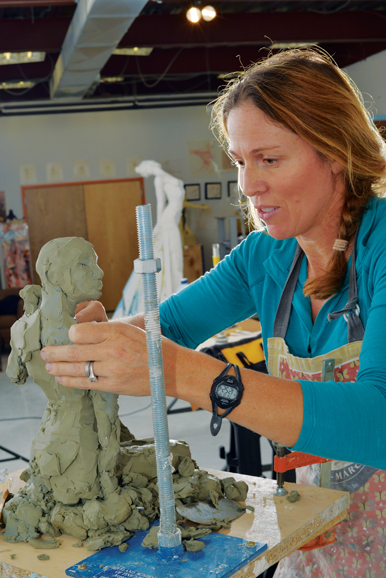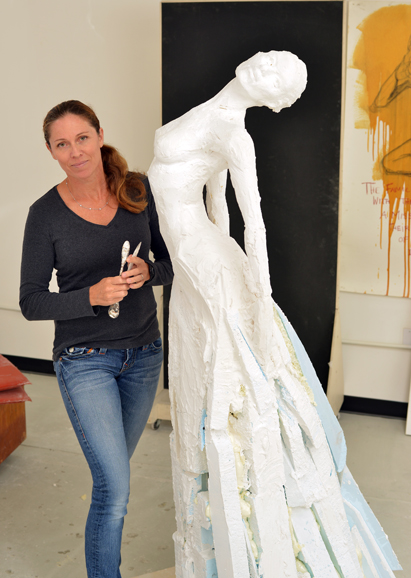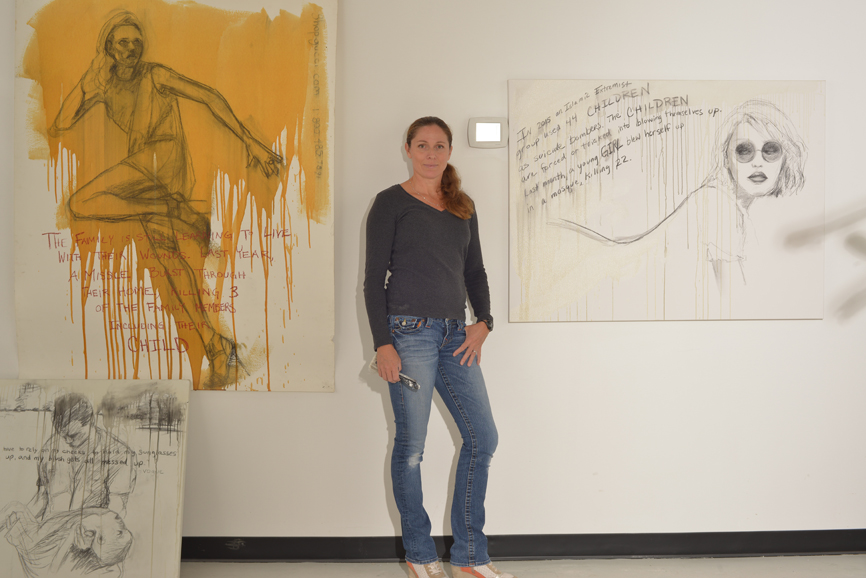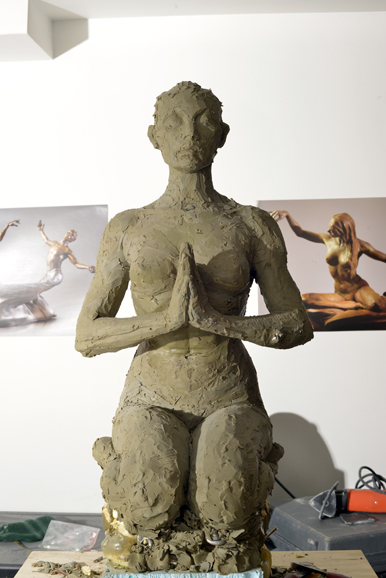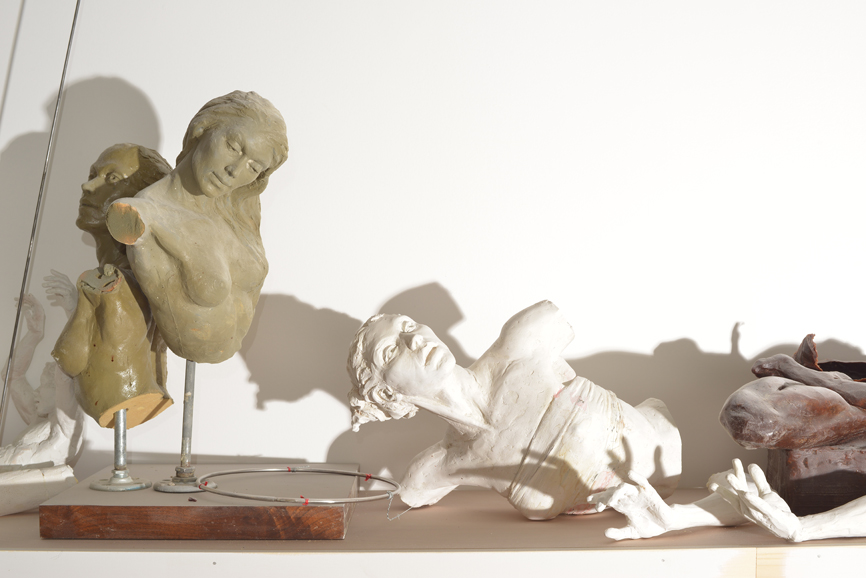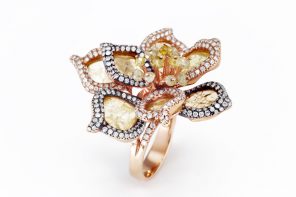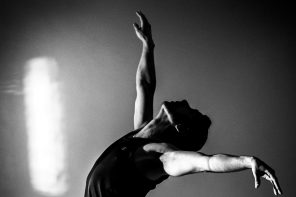Paige Bradley is in her element, her studio, her world.
As a first-time guest, I try to take it all in.
My eyes dart from statues — seated, hanging and mounted — to paintings to drawings to a scattering of heads, arms and hands.
A new one, “Phoenix,” is in the midst of taking shape in foam. Instead of ashes, she’s rising literally from brushes and tools at her feet.
The other statues are sumptuous, lithe, stretching, mid-flight, alive.
The movement of the unmoving.
Your breath catches.
“Wow” comes aloud and involuntarily.
Paige had been watching. She smiles and says, “Thank you.”
That one word said it all, she says.
Her spacious, awe-inspiring studio is on Progress Drive in a quiet section of Stamford.
It’s where she creates while her children are at school and her husband at his work. It’s also where she speaks philosophically about the world and artists — Michelangelo, Rodin and Georgia O’Keeffe — as well as family.
“I owe my mom the world. She always pushed me.”
At the age of 10, Paige was drawing nude models (after her mom had signed a piece of paper at the prompting of a hesitant teacher). She studied, she drew constantly. At 13, the young tomboy was welding in a junkyard. One memorable Christmas present was a drill, “a Makita,” she recalls. “I opened it like some girls opened a Barbie box.”
A call to dinner on a family vacation brought Paige’s reply, “I can’t, my friend’s only got one eye,” referring to the drawing she needed to complete and bring to life before she could sit down and eat.
“Michelangelo had to draw out the spirits from marble. I have to make these people whole,” she says of her artwork. “It has to be whole emotionally. It doesn’t have to be the whole body, whole in the sense of completing the piece.”
Paige grew up on a mountain in Carmel, Calif., — just old people and dogs and no TV signal. But while the area was lacking in playmates, it had a history rich in the arts in which Paige immersed herself. Just as the East Coast had the Hudson River School of 19th-century landscape painters and a later school of American Impressionists, the West Coast had its Impressionists, too, artists such as Granville Redmond and Guy Rose, who painted the Pacific Coast with its rocky cliffs and wind-gnarled trees.
She grew familiar with their works and those in the galleries. In one Carmel gallery, she saw a bronze sculpture, a lyrical form of a female. “I knew I could do that.”
A few years later at the age of 17, Paige won a sculpture contest and cast her first bronze. (She uses that same foundry — Monterey Sculpture Center — to this day.) From there she was on to Pepperdine University, then The Florence Academy of Art in Italy and then the Pennsylvania Academy of Fine Arts. She was an assistant sculptor on a monument for the Olympic Summer Games in Atlanta. At the age of 27, she was voted into the National Sculpture Society. In 2004, she moved her studio from California to New York City. And three years later, she set up shop in London. She and her young family moved to Connecticut in 2015.
On a subsequent visit to her studio, Paige is sitting in a chair with a piece of sculpture nestled in her arms as she adds plaster to refine the woman’s face. With an attentive, loving look, Paige becomes an earth mother to her creation. She delicately dabs on the plaster to the sculpture’s face and wipes away the excess.
Paige tries to use models who are not professionals. She refers to Lucian Freud, a British painter, who thought that professional models brought artificiality into the studio. “You can’t capture the humanity behind the eyes” of a professional, Paige says.
“My work isn’t just capturing the outside,” she says. “It’s what’s inside.”
“I’m shining light on something that’s been in the dark.”
In her artist statement, Paige writes: “I keep moving my work forward by questioning, observing, looking for truth and searching for clarity. My goal is to have the courage to create what feels real, not necessarily beautiful, in order to create lasting, fine art.”
But for Paige, creating sculpture is “painful.”
“To make a bronze you have to destroy to create. Clay is the life. Then it is destroyed to make the mold, which is the death. And then it is reincarnated in bronze, aluminum and resin … to live for eternity.”
And with that said, Paige goes over to the warming box to check on her clay, clay that she has used for more than 20 years and, as she points out, not just oil-based but containing the sweat and history of previous projects.
She is about to create what will eventually become an 18-foot-tall bronze sculpture of the Indian goddess Uma for a client who wants to place it on an island in the Bahamas.
She looks at a photo of Uma and twists the armature to her liking. She then rolls over a tall, adjustable table with two pieces of wood clamped together to serve as the pedestal. Paige scoops up a couple of handfuls of clay and creates a thick base for the aluminum wire to sit on.
With the wire in place, Paige begins.
It’s like the beginning of Maurice Ravel’s “Bolero,” starting out slow with the light tapping of drumsticks and then adding the notes of the flute, then more woodwinds and the brass before the strings and the entire orchestra drive the sinuous pair of themes home.
Paige Bradley begins her “Bolero” slowly.
She works the clay in her hands and places it on the thick wire. She builds the torso first. Small gobs of clay fall on the floor.
Her eyes intent, she adds more and more.
She circles the table. The dance begins.
More clay for the body. She shapes it. She glances at the photo of Uma on her workbench.
She turns the table. Her eyes going up and down, studying.
Paige smiles.
The head takes shape.
Then the legs.
Paige continues to move around what is slowly becoming Uma.
She turns, she dips, reminiscent of the iconic dancing cranes in Japanese textile art.
Watching Paige move, you understand how she infuses movement into her sculptures.
She takes a wooden spatula-like tool and shapes and smoothes Uma’s body.
Paige’s eyes rarely leave Uma.
Paige wrinkles her nose. She smiles.
She adds a crown, then hoop earrings.
Paige ends her dance after 45 minutes. The back of her hand touches the perspiration building on her brow.
The once bare armature is now Uma.
As Paige said earlier, “Clay is the life.”
For more, visit paigebradley.com.

